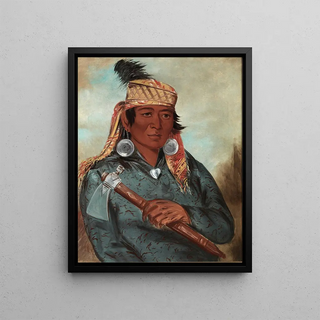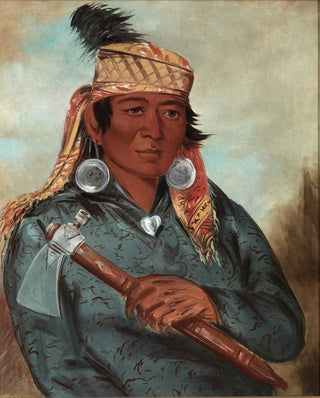Art print | WhPeSay Le Blanc - George Catlin


View from behind

Frame (optional)
In the fascinating universe of art, some works transcend the simple frame of painting to become witnesses of a bygone era and culture. The WhPeSay Le Blanc - George Catlin art print is a perfect example. This piece resonates with historical depth, evoking majestic landscapes and the living traditions of Indigenous peoples of America. Through Catlin's perspective, the viewer is transported on a visual journey, an immersion into forgotten stories where each brushstroke tells a unique story. The magic of this art print lies in its ability to capture the very essence of the human soul, through a prism of colors and shapes that vibrate with emotion.
Style and uniqueness of the work
George Catlin's style is inseparable from his commitment to representing the life and customs of Native American tribes. His technique, characterized by bold use of colors and a keen sense of detail, brings his subjects to life in an almost tangible way. In the WhPeSay Le Blanc - George Catlin art print, we feel this desire to pay homage to often marginalized cultures, while celebrating their intrinsic beauty. The vibrant portraits of chiefs, scenes of daily life, and enchanting landscapes are all testimonies of a world in transition. The way Catlin composes his scenes, integrating narrative and symbolic elements, gives his work an almost cinematic dimension, inviting the viewer to explore every corner of the image.
The artist and his influence
George Catlin, 19th-century artist and ethnographer, established himself as a pioneer in the representation of Native American cultures. His journey, marked by travels across the North American continent, allowed him to meet and document tribes whose ways of life were at risk of extinction. By capturing their essence on canvas, Catlin was not merely creating art but participating in a mission of cultural preservation. His influence endures today, both in the art world and in anthropological studies. Contemporary artists draw inspiration from his approach, blending respect and curiosity, while continuing to explore themes of identity

Matte finish

View from behind

Frame (optional)
In the fascinating universe of art, some works transcend the simple frame of painting to become witnesses of a bygone era and culture. The WhPeSay Le Blanc - George Catlin art print is a perfect example. This piece resonates with historical depth, evoking majestic landscapes and the living traditions of Indigenous peoples of America. Through Catlin's perspective, the viewer is transported on a visual journey, an immersion into forgotten stories where each brushstroke tells a unique story. The magic of this art print lies in its ability to capture the very essence of the human soul, through a prism of colors and shapes that vibrate with emotion.
Style and uniqueness of the work
George Catlin's style is inseparable from his commitment to representing the life and customs of Native American tribes. His technique, characterized by bold use of colors and a keen sense of detail, brings his subjects to life in an almost tangible way. In the WhPeSay Le Blanc - George Catlin art print, we feel this desire to pay homage to often marginalized cultures, while celebrating their intrinsic beauty. The vibrant portraits of chiefs, scenes of daily life, and enchanting landscapes are all testimonies of a world in transition. The way Catlin composes his scenes, integrating narrative and symbolic elements, gives his work an almost cinematic dimension, inviting the viewer to explore every corner of the image.
The artist and his influence
George Catlin, 19th-century artist and ethnographer, established himself as a pioneer in the representation of Native American cultures. His journey, marked by travels across the North American continent, allowed him to meet and document tribes whose ways of life were at risk of extinction. By capturing their essence on canvas, Catlin was not merely creating art but participating in a mission of cultural preservation. His influence endures today, both in the art world and in anthropological studies. Contemporary artists draw inspiration from his approach, blending respect and curiosity, while continuing to explore themes of identity






